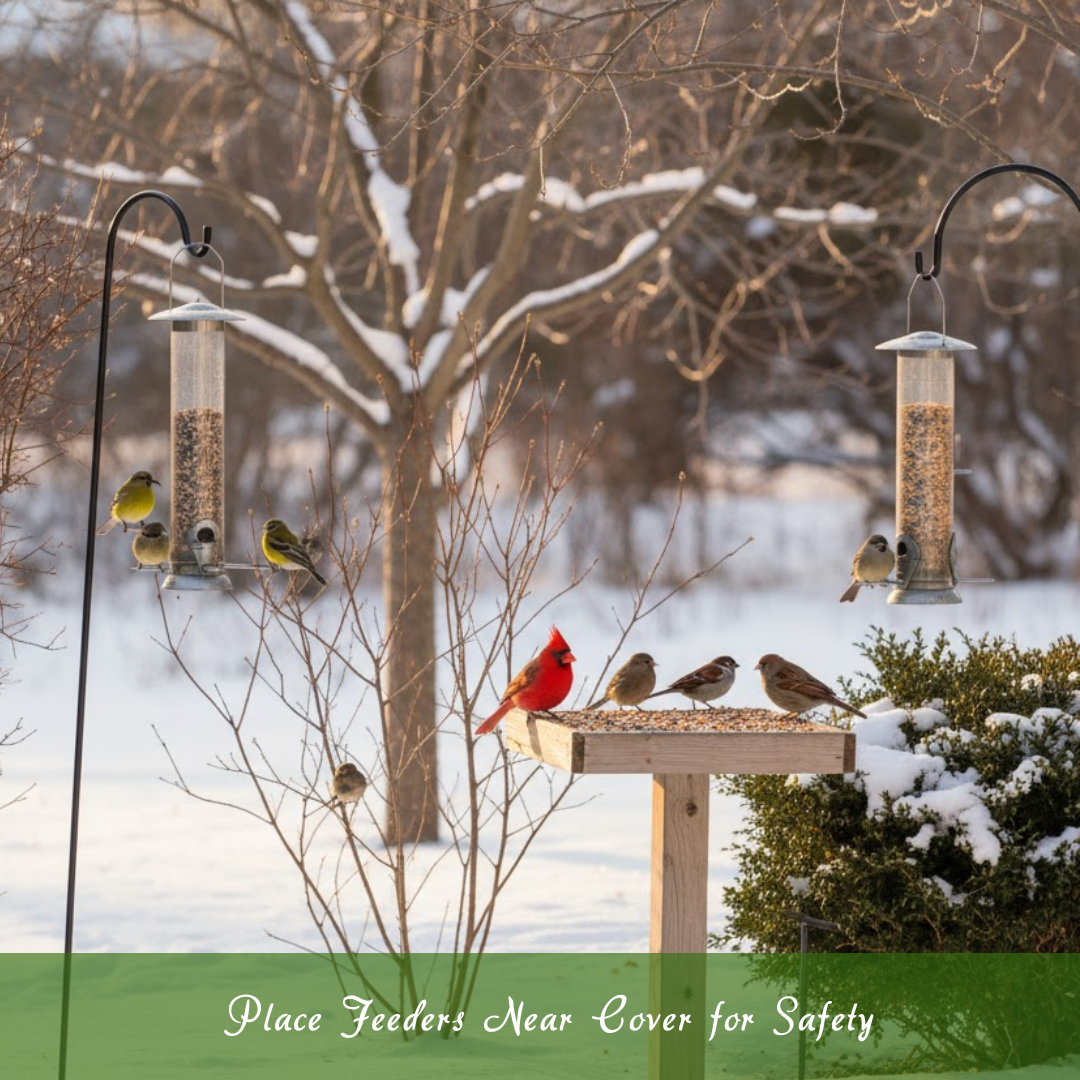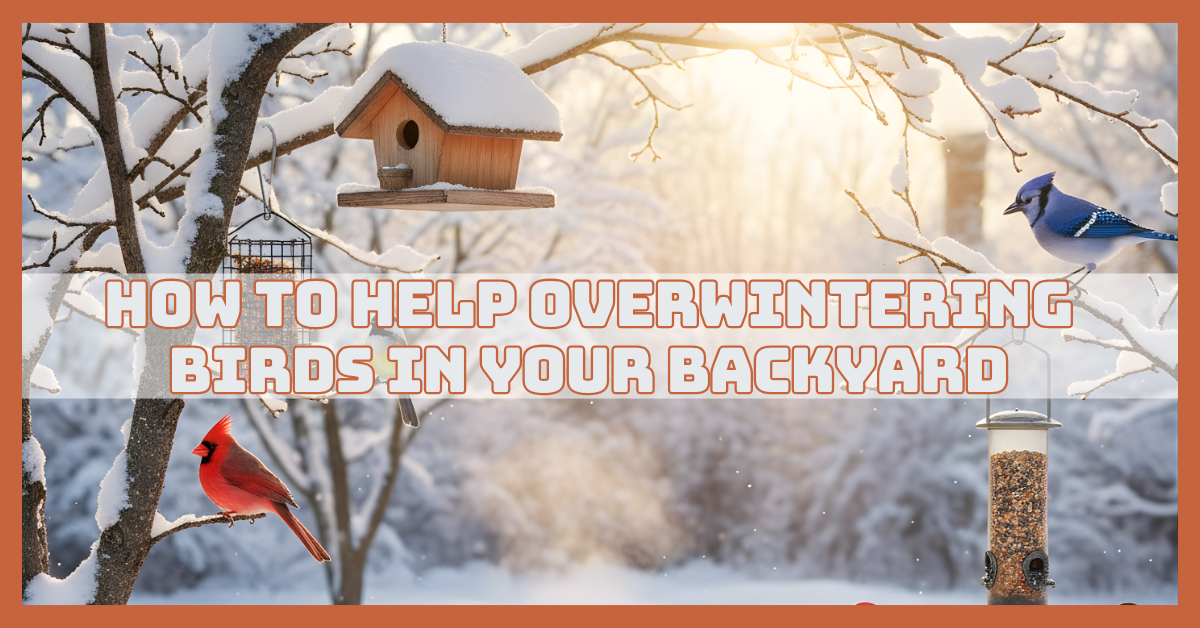How To Help Overwintering Birds In Your Yard
Winter can be harsh on birds. Food becomes scarce. Water freezes. Shelter is limited. Long, cold nights drain energy. Yet many birds choose to stay instead of migrating. They depend on the landscape around them—especially backyards—for survival.
The good news?
Learning how to help overwintering birds in your backyard ensures they have food, water, and shelter during the harsh winter months. This guide shows you how. Let’s make your backyard a lifeline for overwintering birds.
Why Helping Overwintering Birds Matters
Helping overwintering birds matters because winter is the season when they struggle the most. Food becomes scarce, water freezes, and shelter is limited. Birds burn vast amounts of energy just trying to stay warm through long, icy nights.
Many lose a significant portion of their body weight in a single night, so every calorie counts. When you offer food, water, and safe shelter, you become a lifeline during their most vulnerable time.
Supporting these birds also helps maintain a balanced ecosystem. Winter birds eat pests, spread seeds, and help keep nature in harmony even when the landscape sleeps.
By assisting them to survive the harsh months, you also support healthier bird populations in spring, which strengthens the local environment long-term. Beyond that, there’s a personal reward.
Watching colourful cardinals, cheerful chickadees, and energetic woodpeckers brings life and movement to your quiet winter yard. Their presence lifts your mood, reduces stress, and builds a deeper connection with nature.
Helping overwintering birds isn’t just kind—it’s meaningful. Your simple actions can make the difference between survival and struggle for these small, resilient creatures.
1. Provide High-Energy Foods For Winter Survival
Overwintering birds face their toughest season when food, water, and shelter become scarce. Helping them through winter supports their survival during long, freezing nights when they burn immense energy to stay warm.
By offering high-energy foods, unfrozen water, and safe shelter, you give them the essential resources they can’t always find in nature.
Your backyard becomes a small but powerful refuge. These simple actions not only help birds live through harsh weather but also strengthen local ecosystems.
Plus, watching vibrant birds visit your yard brings joy, calm, and a deeper connection with nature during the quiet winter months.
Pro Tips
- Use metal feeders outdoors.
- Keep the suets away from the sun.
- Refill feeders every morning.
- Store seeds in airtight bins.
2. Offer A Variety Of Feeders To Reduce Crowding And Stress
Different bird species have different feeding habits. Using a variety of feeders ensures everyone gets a chance to eat. Tube feeders attract small songbirds like finches and chickadees.
Hopper or box feeders welcome cardinals, sparrows, and doves. Suet cages provide energy to woodpeckers and nuthatches.
Platform or tray feeders suit ground-feeding birds. By offering multiple feeding options, you reduce competition and stress.
Birds feel safer when they have space. Spread feeders apart and place them near shrubs or trees for cover. A little variety goes a long way in supporting healthy, happy winter birds.
Pro Tips
- Space feeders at least six feet apart.
- Mix feeder types for different species.
- Keep feeders near natural cover.
- Rotate locations to prevent predator buildup.

3. Keep Feeders Clean And Stocked For Happy Birds
Clean, fresh food keeps birds healthy all winter. Old or mouldy seeds can make them sick. Wash feeders every two weeks with a vinegar-water mix.
Before replenishing, give them a thorough rinse and allow them to completely dry. Refill feeders regularly, especially during extreme cold or snow, so birds don’t go hungry.
Consistent food supply reduces stress and encourages frequent visits. Check for spilled seeds on the ground and remove them to prevent mould.
Healthy feeders attract more birds and keep your backyard lively. A little maintenance ensures your feathered friends thrive, even in the harshest winter months.
Pro Tips
- Scrub feeders every two weeks.
- Use a vinegar-water solution for cleaning.
- Dry completely before refilling seeds.
- Remove spilled seeds from the ground.
4. Keep Birds Hydrated With Fresh & Unfrozen Water
Water is just as important as food in winter. Frozen puddles make it hard for birds to drink or preen. A heated birdbath keeps water liquid all day and night. If you don’t have a heater, refill the bath often with warm water.
Add stones or branches so birds can perch safely. Place the tub near the shrubs for protection from predators. Clean the birdbath regularly to prevent bacteria buildup.
Providing unfrozen water helps birds stay hydrated, maintain healthy feathers, and survive freezing temperatures. A small effort makes a huge difference for winter wildlife.
Pro Tips
- Use a small heater for birdbaths.
- Refill the bath multiple times daily.
- Add stones for safe perching.
- Place the tub near the natural cover.
5. Plant Winter Berry Shrubs For Natural Food
Winter berry shrubs provide birds with natural, calorie-rich food when seeds are scarce. Berries are full of nutrients and help birds survive cold, harsh months.
Choose native shrubs like holly, viburnum, winterberry, or cotoneaster for best results. These plants offer both food and shelter.
Plant them in areas that are sunny or somewhat shaded, and leave enough space between them to allow birds easy access to berries. Leave berries on the branches through winter—they are a vital resource.
By adding berry-producing shrubs, your backyard becomes a self-sustaining food source. Birds will visit regularly, creating a lively and natural winter scene.
Pro Tips
- Choose native shrubs for the best results.
- Plant in sunny or partially shaded spots.
- Space shrubs for easy bird access.
- Leave berries on branches through winter.
6. Add Roosting Boxes For Warm And Safe Shelter
Winter nights are long and cold. Birds need safe, insulated places to rest. Roosting boxes provide warmth and protection from wind, snow, and predators.
Unlike nesting boxes, they have smaller ventilation holes and thicker walls to trap heat. Place boxes near shrubs or trees so birds feel secure. Multiple birds may roost together to share warmth. Clean boxes annually to prevent disease.
By adding roosting boxes, you create a reliable winter refuge that keeps birds healthy and energized. Even a small backyard can become a cozy sanctuary for overwintering birds with this simple addition.
Pro Tips
- Install boxes near trees or shrubs.
- Use thicker walls for better insulation.
- Keep ventilation holes small and secure.
- Clean boxes annually to prevent disease.
7. Leave Evergreen Trees And Shrubs For Wind Protection
Evergreen trees and shrubs are winter heroes for birds. They block cold winds and provide shelter during snowstorms. Dense foliage traps warmth and creates safe resting spots.
Birds use these areas to conserve energy and escape predators. Pines, spruces, cedars, and hollies are excellent choices. Even small evergreens in your yard make a difference. Avoid cutting them down in the fall—let nature provide cover.
Placing feeders nearby ensures birds can eat safely without exposure. By keeping evergreens, you create a protected, year-round habitat that supports survival and encourages birds to visit your backyard throughout winter.
Pro Tips
- Keep evergreen shrubs untrimmed during winter.
- Plant pines or spruces for dense cover.
- Position feeders near natural windbreaks.
- Avoid cutting trees before the winter season.

8. Create Brush Piles For Cozy Winter Shelter
Brush piles made from fallen branches, twigs, and leaves provide birds with warm, safe hiding spots. They protect small birds from wind, snow, and predators. Simple piles in quiet corners of your yard become natural shelters.
Leave them undisturbed throughout winter so birds can roost safely. Brush piles also attract insects, offering an extra food source—even a small pile benefits wrens, sparrows, and juncos.
Layering leaves and branches creates insulation and warmth. By adding brush piles, you give birds a natural refuge, helping them survive harsh winter conditions while keeping your backyard lively.
Pro Tips
- Use a quiet, secluded corner yard.
- Layer leaves under branches for insulation.
- Avoid disturbing piles during the winter months.
- Include sticks of varying lengths inside the pile.
Turn Your Passion for Nature Into Income
🌿 Whether you love gardening, caring for animals, or exploring holistic living,
You can share your knowledge online and earn from it.
Discover how nature lovers are growing their passions into meaningful, income-generating blogs. 👇
9. Leave Seed Heads On Flowers For Winter Feeding
Dried flower seed heads are nature’s pantry for birds. Goldfinches, sparrows, and chickadees rely on them when other food is scarce. Plants like coneflowers, sunflowers, asters, and echinacea hold seeds through winter.
Avoid cutting everything down in the fall—let the plants stand. Birds enjoy perching while picking seeds, conserving energy. Seed heads also provide shelter from wind and snow.
By leaving them, you create a natural, low-maintenance food source that supports local birds. It’s an effortless way to keep your backyard lively and self-sustaining throughout winter while giving birds essential nutrients.
Pro Tips
- Leave coneflowers and sunflowers standing.
- Avoid cutting plants until spring arrives.
- Spread seed heads near bird feeders.
- Mix tall and short plants naturally.
10. Avoid Pesticides And Chemicals To Protect Birds
Pesticides and chemicals harm more than pests—they reduce insects, berries, and seeds that birds rely on. Even small doses can make birds sick or weaken them during winter.
By avoiding chemicals, you protect natural food sources and support a healthier ecosystem. Native plants thrive without pesticides and provide reliable winter nutrition.
Birds also benefit from insect populations that survive naturally. Choose organic methods for garden care, like compost, mulch, or natural pest control.
A chemical-free yard creates a safe environment for overwintering birds while boosting biodiversity. Simple changes make your backyard a thriving winter haven.
Pro Tips
- Use compost instead of chemical fertilizer.
- Encourage beneficial insects for natural control.
- Choose native plants for winter food.
- Avoid spraying any synthetic pesticides outdoors.
11. Keep Cats Indoors To Protect Winter Birds
Overwintering birds are particularly vulnerable to outdoor cats. Even well-fed cats hunt instinctively. Birds visiting feeders or shelters are easy targets.
Keeping cats indoors dramatically reduces predation and stress on local bird populations. It also keeps cats safer from cars, diseases, and predators. If you have neighbours with outdoor cats, kindly encourage them to keep pets inside.
Creating a safe backyard environment allows birds to feed, roost, and thrive without fear. Small changes in cat management can have a significant impact on helping birds survive the harsh winter months.
Pro Tips
- Keep pet cats indoors year-round.
- Provide indoor entertainment for cats daily.
- Talk kindly to neighbours about cats.
- Install window perches for indoor viewing.
12. Place Feeders Near Cover For Safety
Birds feel safer when feeders are near natural cover like shrubs, trees, or tall grasses. Cover provides quick escape routes from predators.
At the same time, avoid placing feeders too close to spots where cats or other predators can hide. Proper placement reduces stress and encourages frequent visits.
Birds can eat comfortably while keeping an eye on potential dangers. Even minor adjustments in feeder location make a big difference in bird safety.
Observing bird behaviour helps you find the best spots. A safe, accessible feeder keeps overwintering birds healthy and happy throughout the season.
Pro Tips
- Position feeders near shrubs or trees.
- Keep feeders away from dense predator hiding.
- Allow clear flight paths to feeders.
- Monitor bird behaviour and adjust placement.
13. Use Window Decals To Prevent Bird Collisions
Birds often cannot see clear glass and may collide with windows, causing injuries or death. Window decals break up reflections and alert birds to the barrier. Place decals on both sides of the glass for maximum effectiveness.
Patterns like stripes, dots, or silhouettes work best. Cover the entire window area, especially near feeders or perches. The maximum distance between decals should be two inches vertically and four inches horizontally.
This simple step dramatically reduces window strikes. By protecting birds from collisions, you help ensure their safety while enjoying wildlife viewing from inside your home.
Pro Tips
- Apply decals on both window sides.
- Space decals closely for better visibility.
- Use bird-friendly patterns like stripes or dots.
- Cover windows near feeders or perches.

14. Clear Snow And Spread Seeds For Ground Feeders
Deep snow makes it hard for ground-feeding birds to access food. Clearing a small area around feeders helps them reach seeds safely. Spread seeds on packed snow so birds like sparrows, juncos, and doves can find them easily.
This simple step reduces he energy birds expend digging through snow. It also prevents seeds from being buried and wasted. Keep the area clear and refill seeds regularly.
By maintaining accessible feeding spots, you help birds conserve energy and survive harsh winter conditions. Small efforts like this make a big difference for winter wildlife.
Pro Tips
- Clear a path around feeder areas.
- Spread seeds evenly on packed snow.
- Refill seeds multiple times daily.
- Use coarse seeds for easy access.
15. Observe Bird Activity And Adjust Feeders
Watching your birds helps you understand their needs. Notice which species visit most and what foods they prefer. Some birds favour sunflower seeds, others nyjer or suet. Adjust feeder types to match these preferences.
Pay attention to where birds feel safest and move feeders if needed. Small changes in location or food type can reduce stress and increase visits. Seasonal shifts may also affect preferences, so stay flexible.
Keeping a simple journal or using apps helps track patterns. By observing and adapting, you create a bird-friendly environment that maximizes survival and enjoyment throughout the winter months.
Pro Tips
- Keep a birdwatching journal daily.
- Track which food species prefer.
- Move feeders for safer access.
- Adjust types seasonally for variety.
16. Provide Shelter With Evergreen Hedges
Evergreen hedges act as natural windbreaks. Birds use them for protection against harsh winds and snow. Dense foliage offers warmth and a safe resting place. Hedges near feeders allow birds to eat without feeling exposed.
They also attract insects, providing extra food. Even small evergreen plantings make a difference in winter. Leave them untrimmed through the cold months.
By integrating hedges into your backyard, you create a reliable, year-round habitat. Birds are calmer, safer, and more likely to visit. This simple landscaping step ensures your yard remains a cozy winter refuge.
Pro Tips
- Plant thick evergreen hedges strategically.
- Leave hedges untrimmed in winter.
- Place feeders close but not inside.
- Combine with shrubs for a layered cover.
17. Provide Heated Or Insulated Roosting Spots
Cold nights can be deadly for small birds. Heated or insulated roosting boxes keep them warm—line boxes with straw or wood shavings for extra insulation. Place them near trees or shrubs for protection.
Roosting boxes help birds conserve energy, especially during storms. Multiple birds can roost together to share warmth. Clean boxes yearly to prevent disease buildup.
Even a simple insulated box can dramatically improve survival rates. Your backyard becomes a haven, and birds return consistently. This small investment in warmth pays off with healthier, thriving wildlife.
Pro Tips
- Use straw or shavings inside boxes.
- Place boxes near natural cover.
- Ensure boxes are predator-resistant.
- Clean boxes before the new season.

18. Scatter Small Seeds Around Yard For Foragers
Not all birds visit feeders. Sparrows, juncos, and doves often forage on the ground. Scatter small seeds around shrubs, brush piles, and pathways. This gives birds a natural feeding experience.
Avoid burying seeds in snow—they must be visible. Mixing seeds with a small amount of soil or sand keeps them from blowing away.
Providing scattered food helps shy or ground-feeding species thrive. This approach complements feeder-based feeding.
Birds expend less energy searching for food and can maintain body heat more efficiently. Simple scattering increases your backyard’s appeal to a broader range of species.
Pro Tips
- Scatter seeds near shrubs or trees.
- Use small seeds for ground feeders.
- Avoid scattering in deep snow.
- Refresh scattered seeds regularly for safety.
Conclusion
Helping overwintering birds is impactful but straightforward. Understanding how to help overwintering birds in your backyard allows you to create a safe and nourishing environment throughout the winter.
Small actions—like offering high-energy seeds, maintaining feeders, and creating natural cover—make a big difference.
These efforts strengthen local ecosystems, protect wildlife, and bring joy to your winter days. A bird-friendly yard is a winter sanctuary where nature thrives and lives are saved.
I trust you enjoyed this article on How To Help Overwintering Birds In Your Backyard. Please stay tuned for more inspiring guides, helpful tips, and ideas to help you live closer to nature every day.
Take care!
— JeannetteZ
💬 Your Opinion Is Important To Me
Do you have thoughts, ideas, or questions? I’d love to hear from you. Please leave your comments below or email me directly at Jeannette@Close-To-Nature.org.
📚 More Nature-Inspired Reads
Explore more ways to connect with nature, nurture your pets, and live in harmony with the world around you 🌿







